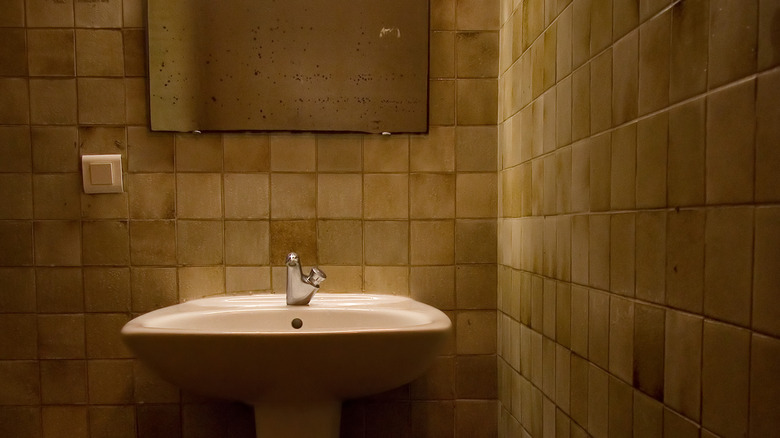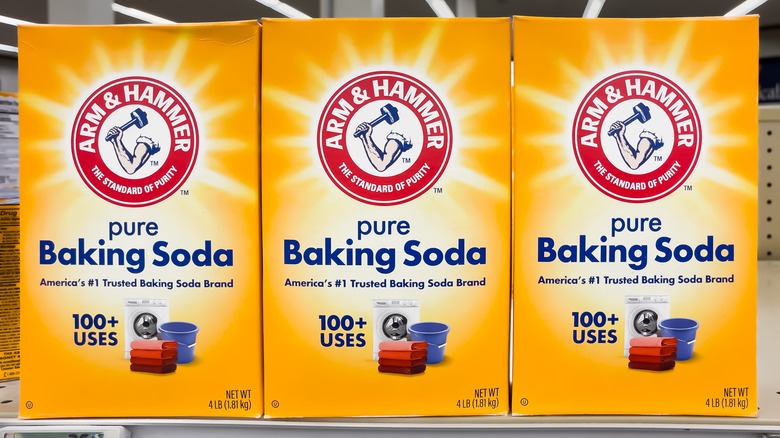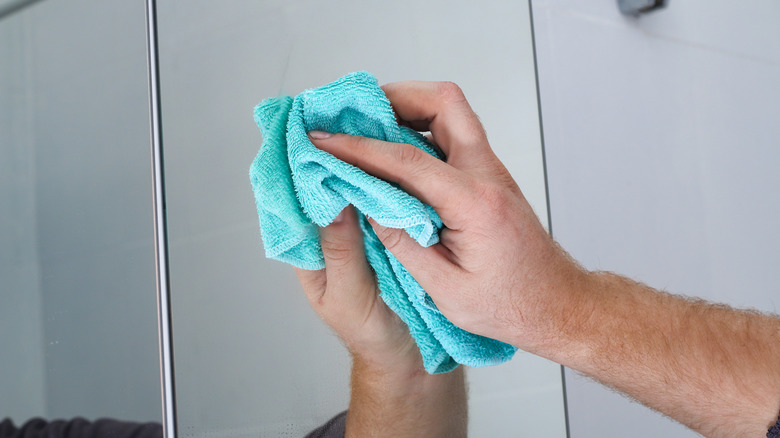The Magic Ingredient That Easily Removes Rust Stains From Your Bathroom Mirror
We may receive a commission on purchases made from links.
A bathroom renovation is definitely on the fixer-upper to-do list, but it probably comes in after the bedroom remodel and that pricey kitchen refit. The mirror, however, will have to be dealt with sooner. It's not the fact that you're leaving streaks on your mirror even after cleaning that's bothering you. It's the unsightly rust stains peppering the surface. While the best treatment for a rusty mirror is prevention, that's not going to help you here. Good news: If rust has already developed, baking soda can help remove current rust spots to a tolerable degree.
If rust-colored stains mar the outer mirror surface, it's likely due to hard water splashes as you brush your teeth or wash your face. This is especially true if your water is high in rust-causing minerals like iron. It could also form around metal fixtures, like the screws or brackets that hold your mirror in place on the wall. Unlike their behind-the-glass counterparts, these types of brown blemishes are easily removed with baking soda. Rust that forms between the glass front and the silver nitrate backing of the mirror goes by a few names: desilvering, mirror rot, tarnishing, or oxidation. Whatever moniker you choose, the cause is the same. Moisture enters the gap between the two surfaces, where the silver nitrate reacts with oxygen, heat, air, and dissolves where it contacts with moisture droplets, creating patches of rust. Preventing this type of rust from forming inside a mirror involves keeping it as dry as possible.
Is baking soda the right tool for removing rust from mirrors?
Some experts say you should never clean your mirror with baking soda because it's abrasive and will scratch. They're mostly referring to the surface of the mirror, not the corroded back. Plus, rust is a tough stain. You need something with a bit of inbuilt scrubbing power to remove it. Vehicle restorers even recommend using steel wool for rust spot removal.
Design professionals and amateur-but-knowledgeable mirror restorers have successfully used metal stripper, brass cleaner, and rust-removing lubricants like WD-40 and an old toothbrush to remove rust and desilvering from mirrors. Baking soda (bicarbonate of soda) is commonly used as a blasting agent to remove paint and light rust from metal in place of a metal stripper, so it's not a stretch to assume its usefulness for mirror repair. While we're not claiming WD-40 is the same, chemically, as baking soda, they both work to loosen or dissolve rust, forcing it from the surface. WD-40 does this through lubrication; baking soda is alkaline, and strong alkalis (like strong acids) dissolve rust.
You can use baking soda to banish stubborn hard water stains on glass mirrors, especially rust-colored marks. Pour a 1:1 ratio of water and baking soda into a jar or bowl, and mix until a slurry forms. Spread this slurry over the rust-stained areas, rubbing it in with a cloth or even just your fingers. Wipe it off with a new, clean cloth, rinsing with fresh water if needed, until the mirror is clear once again.
How to tackle mirror desilvering with baking soda
To remove desilvering, take the mirror down from the wall and apply your baking soda and water paste to the rusty edges. Force it as far into the gap between the mirror's surface and backing as possible with a soft-bristled brush. Let the paste sit on the mirror anywhere from 20 minutes to 1 hour, then wash it off with fresh water. Repeat as many times as you feel is needed.
This technique works best with framed mirrors that unhook or unscrew from the wall. Unframed mirrors are often glued to the wall; in this case, removing the rust (and the mirror) will be a tough, if not impossible, task. Also, don't expect baking soda to offer a perfect rust-removal solution. You might be able to improve the look of the mirror, but the only way to get a perfectly rust-free mirror is to have it professionally resilvered (a pricey and difficult-to-find service), attempt a DIY resilvering, cut or reframe the mirror, or replace it. You can get some really great mirrors for under $80, or simply cover up the unsightly edges with some peel-and-stick mirror trim (available on Amazon for under $10). In other words, scrubbing a rusty mirror down with baking soda might not be worth the effort unless it has sentimental value or is a treasured antique. Note, too, that this technique only works on rust spots right at the edges of a mirror, not in the center, where the baking soda can't penetrate.


